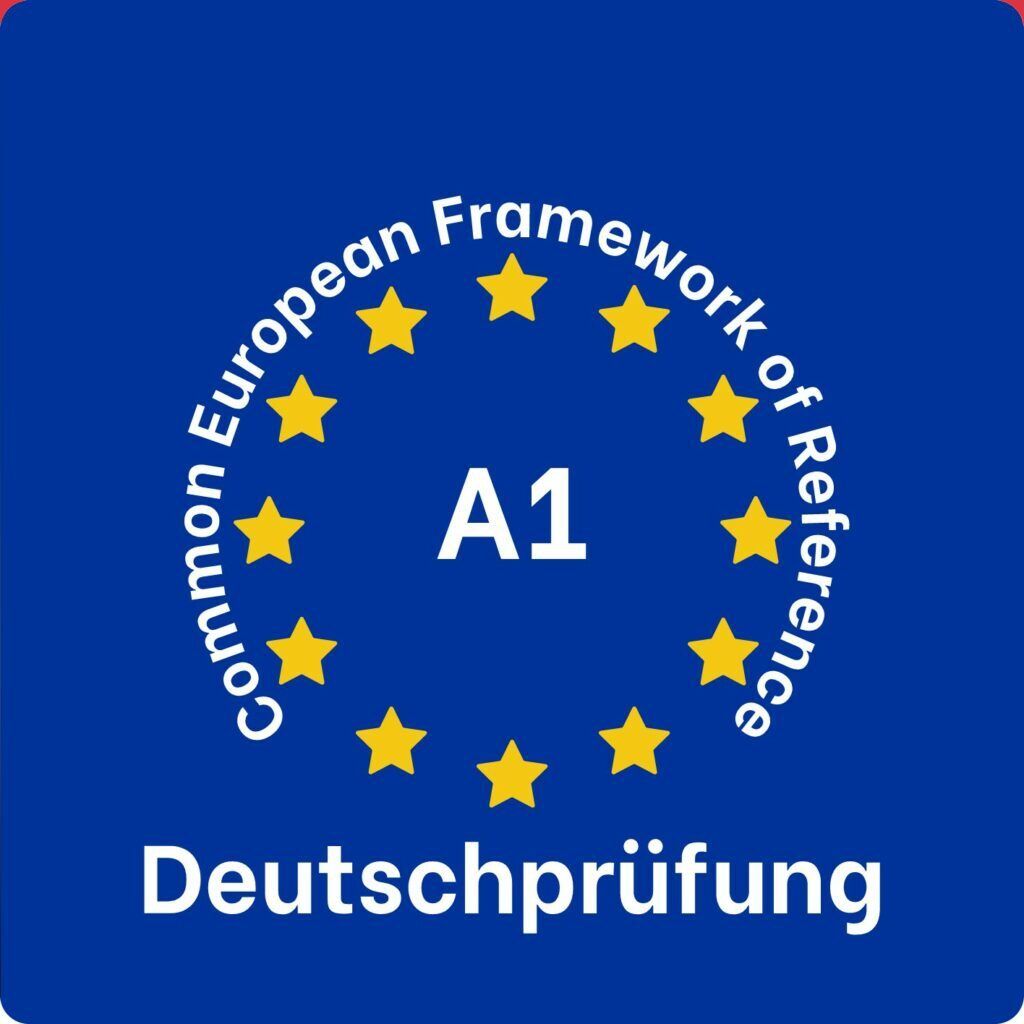The ENA-A1 certificate declares the beginner language level of the first level (A1) of the Common European Framework of Reference for Languages (CEFR). In the exam, the focus is not on productive areas such as writing or speaking, but on receptive skills - reading and listening.

ENA German exams are general language exams and can therefore be used in a wide range of contexts. The A1 ENA German test was developed for test takers who have reached the age of 16 in the year of the test and are learning German as a foreign language as well as a second language. We maintain neutrality in the development of our tests with regard to age, culture, origin and gender. The ENA German tests are used by people who require an official certificate. The exam is for people who want to apply for an au pair position in Germany, for example, or who need proof of language proficiency for spousal reunification, or who simply want to prove their learning success at A1 level. Use our model exam ENA-A1 to prepare for the exam!
Test takers can understand and use familiar, everyday expressions and very simple sentences aimed at satisfying specific needs. They can introduce themselves and others and ask other people questions about themselves - e.g. where they live, what kind of people they know or what kind of things they have - and can answer questions of this kind. They can communicate in a simple way if the person they are talking to speaks slowly and clearly and is willing to help. The language is used exclusively in the private sector.
Test takers can understand instructions given slowly and clearly, follow short simple directions, understand when spoken very slowly and carefully and when long pauses allow time to grasp the meaning and understand time, numbers, quantities and prices.
Test takers can read and understand very short, simple texts sentence by sentence by picking out names, words and the simplest phrases and, if necessary, reading the text several times. They can find concrete, predictable information in simple everyday texts, e.g. in adverts, brochures, menus, bibliographies and timetables. You can locate individual items of information in lists (e.g. in a street directory or an index). You can find the information you are looking for (e.g. in the "Business directory"
find a tradesman). Can understand short, simple written directions. Can understand common signs and signs in public places such as streets, restaurants, railway stations or workplaces, e.g. signposts, mandatory signs, warnings of danger. Can understand very short and simple messages (e.g. postcards, emails). You can recognise familiar names, words and very basic phrases in simple messages in connection with the most common everyday situations. They can get an idea of the content of simple information material and short, simple descriptions, especially if there are visual aids.
You can ask for or pass on information from everyday life in short messages. You can enter personal data such as your name, nationality, age and date of birth in forms, e.g. registration forms at hotels or when entering the country,
Enter the date of arrival etc. You can write simple phrases and sentences about yourself and others:
where they live and what they do. The following text types can be mastered: Form (e.g. registration)
(Post) card, short personal letter, short fax or e-mail short simple note or message.
You can use simple, mainly isolated phrases to talk about people and places. They can say what he/she does for a living and where he/she lives. They can communicate in a simple way, but communication is entirely dependent on repeating, rephrasing or correcting things more slowly. They can ask and answer simple questions, make simple statements or respond to them, as long as they are about immediate needs or very familiar topics. They can understand everyday expressions aimed at satisfying simple, concrete needs when understanding dialogue partners are present.
directly to him/her and speak slowly, clearly and with repetition. They can understand questions and instructions as long as they are addressed to him/her clearly and distinctly. They can follow short, simple directions. You can introduce someone and use simple greetings and farewell phrases. You can ask someone how they are and respond to news.
You can ask someone for something and give someone something. Can ask questions about a person - e.g. about their place of residence, acquaintances
things you own, etc. You can give answers to relevant questions. You can deal with numbers, quantities, prices and times. You can give times using phrases such as "next week", "last Friday", "in November", "at three o'clock". You can answer simple, direct questions about yourself in an interview if the questions are asked slowly, clearly and in direct, non-idiomatic language.

The ENA German exam A1 consists of two parts: Writing (50 points) & Speaking (50 points). The "Writing" exam consists of reading comprehension, text elements and written expression. The "Listening & Speaking" exam includes the oral part of the exam and listening comprehension. The ENA German exam A1 can be taken either as a complete exam or as a partial exam. The entire exam takes about 100 minutes (+ 10 minutes for formalities and +10 minutes preparation time).
The ENA German A1 exam has a total of 100 task points that can be achieved. The reading comprehension section accounts for 20-25 points. The distribution of points varies depending on the exam.
The ENA German A1 exam has a total of 100 task points that can be achieved. The Text Elements section accounts for 20-25 points. The distribution of points varies depending on the exam.
The ENA German A1 exam has a total of 100 task points that can be achieved. The written expression section accounts for 10-15 points. The distribution of points varies depending on the exam.
The ENA German A1 exam has a total of 100 task points that can be achieved. The listening comprehension section accounts for 20-25 points. The distribution of points varies depending on the exam.
The ENA German A1 exam has a total of 100 task points that can be achieved. The oral expression section accounts for 15-20 points. The distribution of points varies depending on the exam.
In three tasks, the comprehension of authentic and simple texts is tested in terms of the overall message and individual content. Approximately 30 minutes are required for reading comprehension. In a "cloze texts" task, gaps in simple texts are filled in with given words (vocabulary, verbs, prepositions, etc.) in approx. 15 minutes.
In two tasks, the written expression is tested by filling out forms. This takes about 5 minutes. This is followed by a free writing task. This involves writing approx. 30 words with a simple sentence structure. with the help of two to three pieces of guiding information. This will take about 10 minutes.
Listening comprehension is tested in two to four tasks using simple and short listening texts in dialect-free German. The audios may be listened to twice. Depending on the task, questions about the text are answered in writing or orally with the recording of your own voice at the touch of a button on the PC.
Speaking is tested in three tasks. The preparation time is 5-10 minutes. First, a short conversation (2 minutes) with the examiner is used to ask and answer specific questions. This is followed by two short, simple tasks (3 minutes each) on oral production (e.g. numbers, letters, pictures).
READING COMPREHENSION & TEXT ELEMENTS
Task types:
Task objectives:
Text types:
WRITTEN PRINTOUT
Text types:
HEARING
Task types:
Task objectives:
Audio (video) types:
ORAL EXPRESSION
Task types: (conducting a monologue)
Task objectives: (conduct dialogue)

Enalingua – Ihre Sprachschule in Frankfurt Bockenheim.Wir helfen Ihnen, Deutsch erfolgreich zu lernen und Ihr Sprachniveau von A1 bis C2 zu erreichen – online oder vor Ort in Frankfurt am Main.
© enalingua 2021 All Rights Reserved.